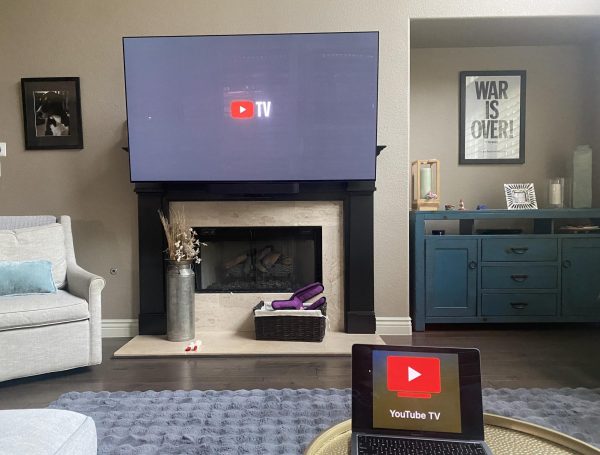COVID-19: The Death of Movie Theatres
Theatre Industry Struggles to Stay Open, Companies Find Other Ways to Release Films
Photo by uberculture on Creative Commons
As a result of COVID-19, many companies, such as movie theatres have struggled to remain operational, even after the end of the quarantine mandate. With the evolution of streaming services and without the promise of new movies, many theatre companies have gone bankrupt. Will COVID-19 be known as the death of the theatre industry?
April 6, 2021
At the start of the quarantine mandate in 2020, many businesses struggled to remain operational without the income earned from customers. Among the small shops and restaurants, the movie theatre industry was one of the many businesses that faced the possibility of permanent closure. Unable to rely on the production of new films and without the ability to successfully adapt to new quarantine regulations, COVID-19 may be the cause of the death of movie theaters. As a result, the pandemic has led to the rapid evolution of the accessibility of newly-released films.
As one of the largest movie theatre organizations in the world, The National Association of Theatre Owners, or NATO, has worked alongside Directors Guild of America (DGA), the Motion Picture Association (MPA) and numerous directors in an attempt to save movie theatres from going out of business. According to NATO, the pandemic has caused 93% of movie theatre companies to suffer significant losses and almost 75% of their usual income. However, despite their best efforts, it appears that many movie theatres will not recover from these losses.
Earlier in March, the popular Alamo Drafthouse chain filed for bankruptcy after it was unable to reopen two-thirds of its theatres according to USA Today. The company plans on closing multiple locations throughout the country, including two in Texas. Nonetheless, the chain hopes for a brighter future as they negotiate with companies such as Altamont Capital and Fortress Investment Group. They are not the only movie theatre chain that suffered; after attempting to reopen a few locations in February and March, companies such as Regal, AMC and Cinemark have announced the closure of most sites for at least another 12 weeks.
To combat the lack of customers and movie options a few theatre companies have found unique ways to gain popularity once again. According to CNBC, AMC plans on lowering the price of tickets to just 15 cents once they are able to reopen. The movie theatre will also be showing throwback films such as “Back to the Future” and “Grease” until new movies are released. Similarly, theatres such as Moviehouse and Eatery allow customers to rent an entire theatre for $150. The private watch party plan guarantees that customers will only be surrounded by the people they invite, limiting exposure while watching a film. Nevertheless, movie theatres are still struggling to bring back the pre-pandemic crowds.
Along with the lack of customers, theatres have wrestled with a lack of content while companies such as Disney adapted to appeal to a population that was stuck in quarantine. On Nov. 12, 2019, Disney launched their new streaming service, Disney Plus, providing yet another streaming app that became an extremely popular form of entertainment for people stuck at home during the pandemic. As a result, even when Texas Governor Greg Abbott permitted the re-opening of business, including movie theatres, it soon became clear that customer interests had shifted, especially with the pandemic still looming over the country.
Following this shift in customer interest, Disney began offering new movies, such as “Mulan,” “Raya and the Last Dragon” and “Soul” on Disney Plus. In fact, as Forbes, an American business magazine, stated in an article, 50% of homes in the U.S with children under the age of 10 had subscribed to Disney Plus by the end of 2020, and thus had multiple movie options to watch from home. While some of the newest content requires an additional premium fee to watch for the first few months, eventually Disney Plus allows all members to watch the films. Other services, such as HBOMax, offered anticipated movies such as “Wonder Woman 1984” as soon as the films were released in theatres.
Additionally, other popular streaming services, such as Netflix, have hit an all-time high as people look to TV for entertainment while stuck at home. Despite economic uncertainty, most streaming services have gained subscriptions as first-time users turn towards television as a way of coping with boredom and anxiety during this time of uncertainty, as Forbes notes in the article “How Is The Quarantine Affecting The Streaming Wars.”
While streaming movies from home had started before the pandemic, this more direct method of releasing movies is an original adaptation to quarantine challenges, with many other companies either following Disney’s path or pushing the release dates for films to next year. And with the multiple streaming services available, movie theaters lack the content needed to gain the same crowds that they had before COVID-19, as explained by CNBC.
As COVID-19 regulations begin to loosen up, movie theatres continue to desperately promote their businesses in an attempt to stay open. Many big-theatre names have had to close a variety of locations. There is no question that the pandemic has brought significant changes to the world, including the movie theatre industry, which may never recover from the worldwide shutdown. With the end of COVID-19, will a new era of movie-watching emerge? Or will movie theatres overcome the challenges that threaten to put them out of business?




![Walking through the tunnel created by the cheerleaders and Celebrities, senior Frances Tran smiles as the soccer team is sent off during DEN for their playoff game against Rouse tonight. Tran said the wins against Smithson Valley and Alamo Heights gave the team a morale boost to take on the Raiders tonight. “I know we were not 100% confident in those games,” Tran said. “But, Rouse is a big opponent for sure. We’re definitely going into tonight with a lot of morale [because of the previous wins].”](https://cphswolfpack.com/wp-content/uploads/2024/04/frances-tran.jpg)



![Holding a bucket of materials in one hand and a roll of tape in another, anatomy and biology teacher Tyler Terry prepares for a lab. Terry said his proudest moments are when his students are happy to see him. “When I take my wife to a football game or something and a bunch of students want to say hi to me or they like to smile and wave and it just makes me feel good that the students are really kind and supportive of me,” Terry said. “[I’m also] proud when I see students perform really well in their extracurriculars because I can see how hard they’re working in my classes, [so] when I see that they’re also working so hard in other things. Like they’re winning band competitions or they’re getting awards for their theater productions, or I see them put on their choir shows, that’s like, wow, you guys are incredible.”](https://cphswolfpack.com/wp-content/uploads/2024/04/Rags-6.png)



![Catching a ball, junior Alivia Robinson plays at the Cedar Park vs Glenn game. Having played since she was 5 years old, she is dedicated to softball and has committed to UTPB for softball. “When I got my offer it took me a very long time to decide where,” Robinson said. “Softball has always been my dream for college, and UTPB is my fit. When [I committed] I knew I was going to be loved and supported.”](https://cphswolfpack.com/wp-content/uploads/2024/04/Lilly-Adams-3.13aliviaedit-901.jpg)































![Holding her dog, Nova, senior Ariana Balakrishnan poses for her senior pictures while Nova wears a bandana with her college decision. Balakrishnan applied to 18 colleges in total, but she decided on Columbia in the end. “Right before I clicked the button to open Columbia’s letter, I literally looked at the camera and go ‘This is just gonna really suck because I wanted it so bad,’ and I clicked it and all of a sudden you hear trumpets,” Balakrishnan said. “There’s a video that plays when you open it and I actually didn’t watch the video, I just watched the screen go black, because every day of December before ED [Early Decision] I would go on YouTube and watch the acceptance video to manifest it, so immediately when the screen went black, I started screaming and jumping up and down. And my parents in the video are like ‘What are you doing, where’s the letter,’ and I was just screaming ‘I got in, I got in.” I just started crying, and it just felt like everything in the world came together.”](https://cphswolfpack.com/wp-content/uploads/2023/04/ariana-2-300x217.jpg)


![Catching a ball, junior Alivia Robinson plays at the Cedar Park vs Glenn game. Having played since she was 5 years old, she is dedicated to softball and has committed to UTPB for softball. “When I got my offer it took me a very long time to decide where,” Robinson said. “Softball has always been my dream for college, and UTPB is my fit. When [I committed] I knew I was going to be loved and supported.”](https://cphswolfpack.com/wp-content/uploads/2024/04/Lilly-Adams-3.13aliviaedit-901-600x400.jpg)




